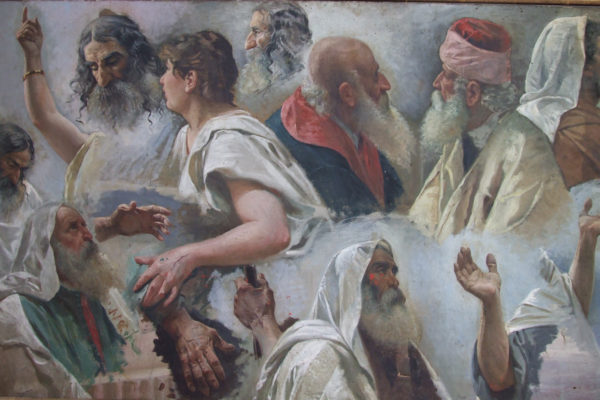Alongside the large-scale paintings of historical and religious subjects presented at the most important public exhibitions and made on commission, during his years in Rome the artist also produced pleasant subjects in a small format, destined for the homes of the new middle class, who particularly appreciated gallant scenes in Renaissance dress like this one here presenting the great Raphael as a yearning lover, a widespread theme that appealed to Romantic taste.
La Fornarina Surprised by Raphael (bozzetto)
1
Pietro Aldi
Manciano, 12 July 1852 – 18 May 1888
Born into a family of wealthy landowners, Pietro Aldi in 1864 enrolled in the Istituto di Belle Arti in Siena, directed by Luigi Mussini. He won the triennial competition in 1873 and the following year, with The Defeat of Conrad of Swabia at Tagliacozzo, won a Biringucci fellowship from the Società di Esecutori di Pie Disposizioni in Siena which enabled him to study in Venice, Florence, and Rome, where he worked with Cesare Maccari. In 1876 he sent The Adulteress to Siena as an example of his studies, but in early 1877 he was forced to return to Manciano because of ill health, a problem that unfortunately would become frequent.
In 1878 he presented in Rome Buoso da Dovara, which was a great success. In 1880 he painted The Virgin and Child Appearing to St. Paul of the Cross for the convent of the Passionist Fathers on Mount Argentario. That same year, he did The Funeral of Pompey the Great, shown in Turin in 1881, and in 1883 participated in the international show in Rome with The Final Hours of Sienese Liberty, to critical acclaim; that same year, he frescoed two funerary chapels in the Misericordia Cemetery in Siena: The Intercessory Angels in the Pollini chapel and Charity in the Franci chapel. The following year he painted St. Joseph with the Christ Child for the church of San Nicola in Sorano and finished two large pictures for Pitigliano cathedral with important moments from the life of Pope Gregory VII.
In 1886, in the Risorgimento Room of the Palazzo Pubblico in Siena, he painted The Meeting at Vignale and the very famous Meeting at Teano. Two years later he presented a large-scale painting of The Triumph of Judith now in the Vatican Museum. At the same time he began work on the canvas of Nero Watching Rome Burn, intended to be shown at the 1889 International Exposition in Paris, but it remained unfinished at his death.
Memo ( Nicodemo) Vagaggini
Santa Fiora 1892 – Florence 1955
After studying in Florence, Memo Vagaggini was sent to the warfront where he was wounded. Returning to his home town, in 1918 he met his future wife Gina Dumonal, a student of Giacomo Grosso at the Accademia in Turin. In the following years Vagaggini alternated stays in Tuscany and in Turin, where he encountered the art of Felice Casorati, which inspired the limpid, abstract visions he exhibited at the Promotrice di Belle Arti in Turin; among them was Impression of the Valle d’Aosta, bought by the Italian royal family in 1920. Starting in 1927, besides painting he worked as an illustrator for the publishing houses Barbera in Florence and Corticelli in Milan. At the end of the 1920s he was named representative of the Italian government at the Villa Romana in Florence, where he met the director Hans Purrmann, a student of Matisse and openly anti-Nazi, who introduced him to Ottone Rosai and Giovanni Papini. In 1938 Vagaggini won the Carnegie Prize in Pittsburgh; the Kraft and Steinhauslin families were among his assiduous collectors. He continued to paint Maremman landscapes which, presented at the most important art fairs, were bought by modern art galleries in Asti, Bari, Rome, Florence, and Milan, and by many private patrons.
Modest and reserved, but determined as befitting his Mount Amiata origins, he remained faithful to landscapes painted from life, serene and composed in a noontime light, until his untimely death.



